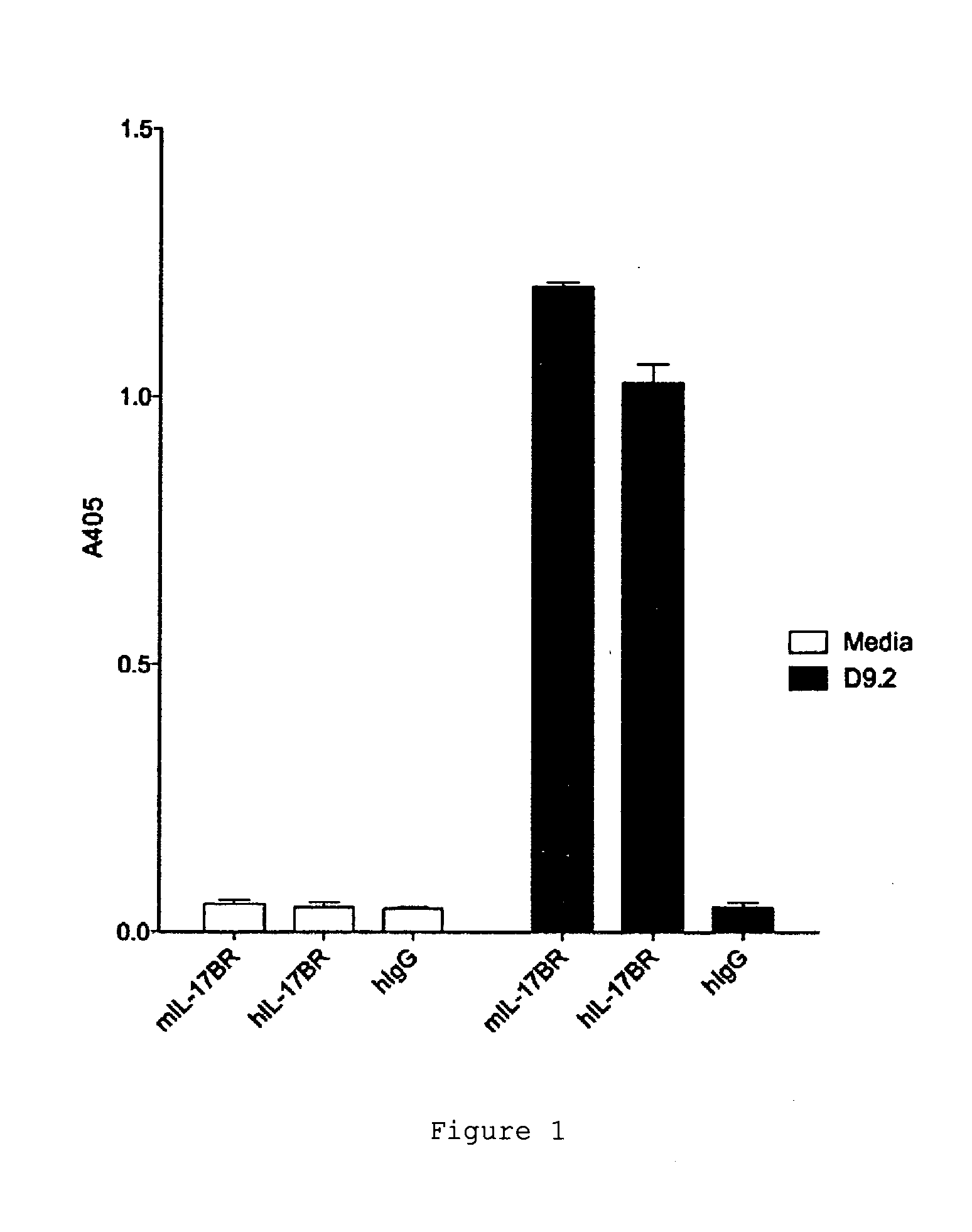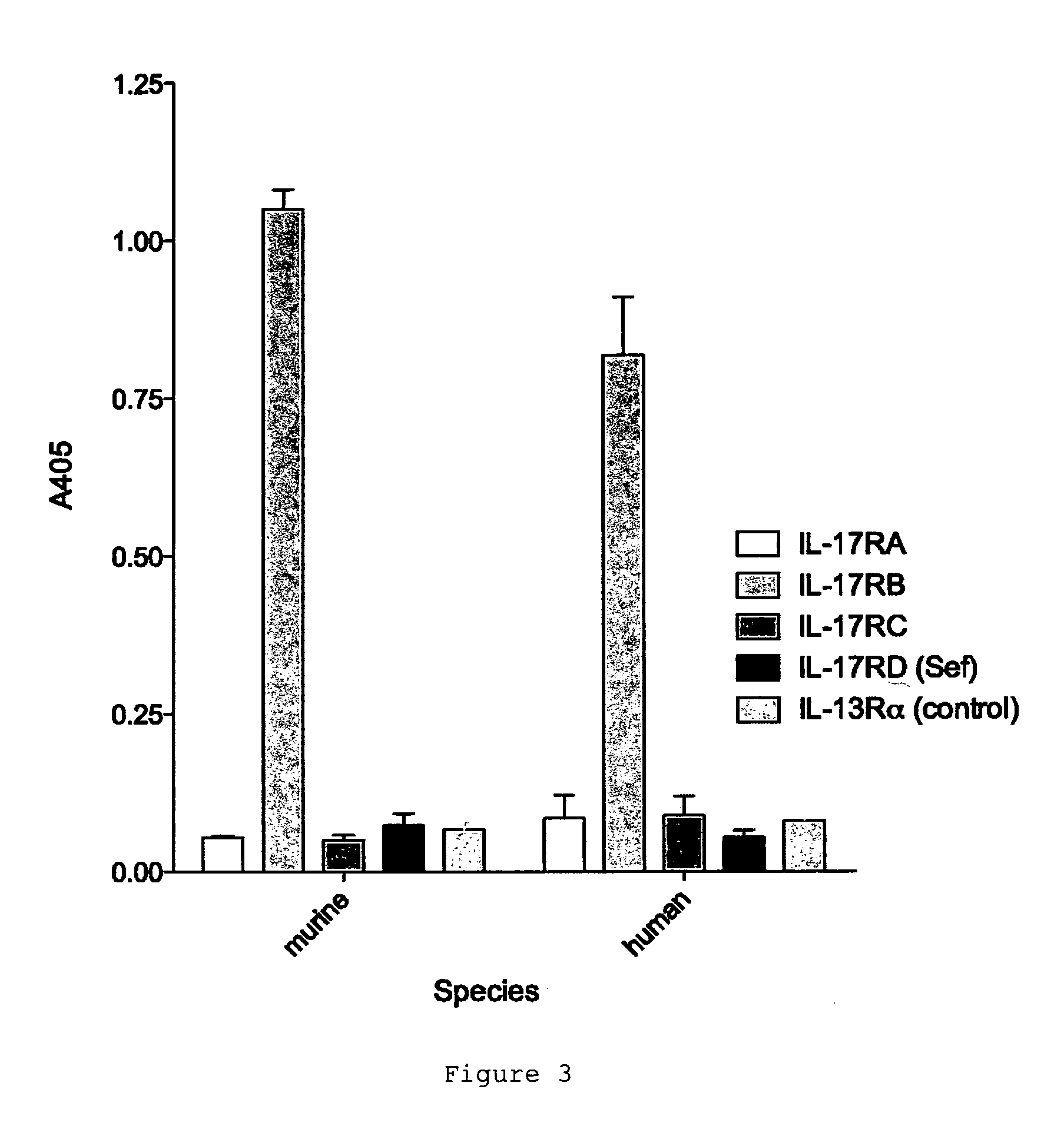Antibodies against il-17br
a technology of il-17br and anti-il-13, which is applied in the field of anti-il-17b receptors, can solve the problems of not being able to induce or maintain clinical remission in patients, and achieve the effects of reducing the number of il-13-producing cells, preventing airway inflammation, and reducing the level of il-13
- Summary
- Abstract
- Description
- Claims
- Application Information
AI Technical Summary
Benefits of technology
Problems solved by technology
Method used
Image
Examples
example 1
Generation of Antibodies Against IL-17BR
[0198]We initially attempted to generate antibodies by immunising mice with synthetic peptides derived from the amino acid sequence of human IL-17BR. Despite generating monoclonal anti-peptide antibodies we failed to produce antibodies that would recognise the mature human IL-17BR protein. We then attempted to generate antibodies against a fusion protein of the human IL-17BR protein by immunising wild-type mice. Despite multiple immunisations and hybridoma fusions, we failed to generate high affinity antibodies against IL-17BR.
[0199]Mice also express a form of IL-17BR and we hypothesised whether our inability to raise a useful antibody was constrained by the lack of novel epitopes between the mouse and human IL-17BR molecules. We generated an IL-17BR-deficient mouse line that would no longer express IL-17BR. The IL-17BR-deficient mice were designed to remove all forms of IL-17BR including alternatively spliced variants. The high degree of cons...
example 2
In Vitro Testing of D9.2
[0202]The specificity of D9.2 was tested by assaying the interaction of D9.2 with other IL-17 receptor family members. D9.2 did not cross-react with IL-17A receptor (IL-17RA), IL-17C receptor (IL-17RC) or IL-17D receptor (IL-17RD) (FIG. 3).
[0203]The screen identified several antibodies which bound IL-17RB, however only D9.2 was able to inhibit the interaction between human IL-25 and human IL-17BR (FIG. 4).
[0204]D9.2 was tested for its ability to inhibit the biological activity of IL-25. IL-25 induces the release of type-2 cytokines, such as IL-13, initially from innate non-B / non-T (NBNT) cells (Fallon et al., 2006; Fort et al., 2001) and from T cells (Angkasekwinai et al., 2007). Furthermore, both human TK-10 (a renal carcinoma cell line) and mouse renal carcinoma (RENCA) cell lines secrete the chemokine IL-8 (known as KC in the mouse) in response to stimulation with TNF-α and IL-25 (Sayers et al., 1990).
example 3
Experimental Model of Allergic Asthma
[0209]BALB / c mice were first sensitized with the antigen OVA, before being challenged with aerosolised OVA. Sensitised and challenged BALB / c mice develop a distinctive asthma phenotype. This is characterised by increased AHR following exposure to the provocative agent methacholine, eosinophil infiltration of the airways, goblet cell hyperplasia and serum IgE secretion, as compared to control BALB / c mice challenged with PBS.
[0210]Using this model, BALB / c mice were treated at the challenge phase with either isotype control anti-c-myc IgG1 (clone 9E10.2) or anti-IL-17BR clone D9.2. Significantly, administration of D9.2 reduced the levels of IL-13 produced following antigen challenge and IL-5 produced following antigen restimulation to levels similar to those found in the absence of antigen challenge or in IL-17BR-deficient mice (FIGS. 8a and b). Numbers of IL-13-producing cells in the lungs of antigen challenged mice were also reduced to such levels...
PUM
| Property | Measurement | Unit |
|---|---|---|
| temperature | aaaaa | aaaaa |
| concentration | aaaaa | aaaaa |
| concentration | aaaaa | aaaaa |
Abstract
Description
Claims
Application Information
 Login to View More
Login to View More - R&D
- Intellectual Property
- Life Sciences
- Materials
- Tech Scout
- Unparalleled Data Quality
- Higher Quality Content
- 60% Fewer Hallucinations
Browse by: Latest US Patents, China's latest patents, Technical Efficacy Thesaurus, Application Domain, Technology Topic, Popular Technical Reports.
© 2025 PatSnap. All rights reserved.Legal|Privacy policy|Modern Slavery Act Transparency Statement|Sitemap|About US| Contact US: help@patsnap.com



